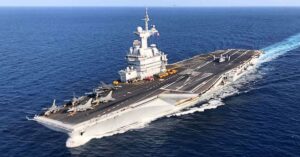
Australia Makes Largest Ever Drug Bust Worth $760 Million Off Queensland Coast, 13 Arrested
December 2, 2024
China’s Coast Guard Patrols Disputed Scarborough Shoal In South China Sea
December 2, 2024

The French aircraft carrier Charles de Gaulle, Europe’s most powerful warship, is sailing towards India, set to arrive by mid-December 2024.
This nuclear-powered carrier is leading a strike group of three other French warships to the Indo-Pacific in a show of strength against China.
The Charles de Gaulle, a 42,500-ton nuclear-powered aircraft carrier, will be in India for joint exercises with the Indian Navy.
These drills are expected to involve one of India’s aircraft carriers, either INS Vikrant or INS Vikramaditya, strengthening defence ties between France and India.
The Charles de Gaulle will also bring along the naval version of the Rafale fighter jets, the same aircraft recently ordered by India for its navy.
Additionally, India has also purchased more French-made Scorpene submarines. This visit is a clear signal from France, showing its continued commitment to the Indo-Pacific region, even while dealing with the ongoing Russia-Ukraine conflict.
At the same time, an Italian delegation is also expected to arrive in India. Led by a junior defence minister and an admiral, the delegation will be aboard the Amerigo Vespucci, a historic sailing vessel used for naval training.
This visit follows India’s decision to lift its ban on Leonardo, an Italian defence company. India-Italy defence ties are also strengthened with regular talks between Indian Prime Minister Narendra Modi and Italian Prime Minister Giorgia Meloni.
On the other hand, India’s defence relations with the UK are also advancing. The two nations recently signed a Statement of Intent to co-develop Integrated Full Electric Propulsion Systems for Indian naval ships.
The deal aligns with India’s Atmanirbhar Bharat (Self-reliant India) mission, enhancing indigenous capabilities and reducing dependence on foreign technology.
This collaboration, led by Rajeev Prakash of India’s Ministry of Defence and Rear Admiral Steve McCarthy from the UK’s Ministry of Defence, will focus on incorporating advanced propulsion systems in future Indian naval vessels, improving fuel efficiency, operational stealth and reducing environmental impact.
References: Times Now, The Defence Times
Source: Maritime Shipping News


